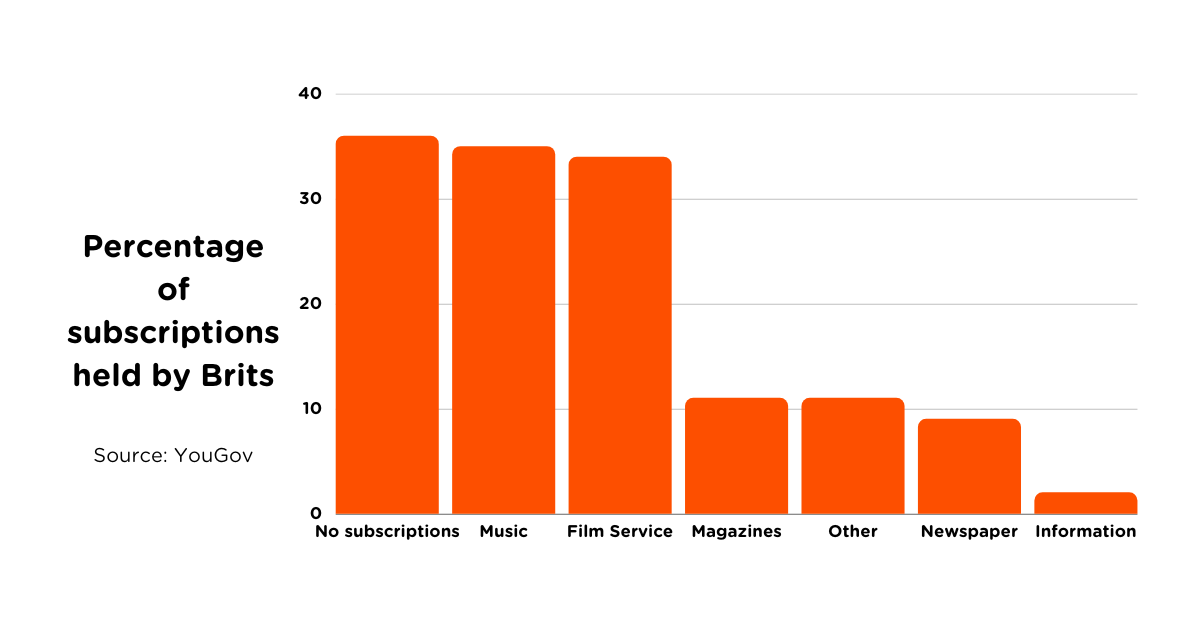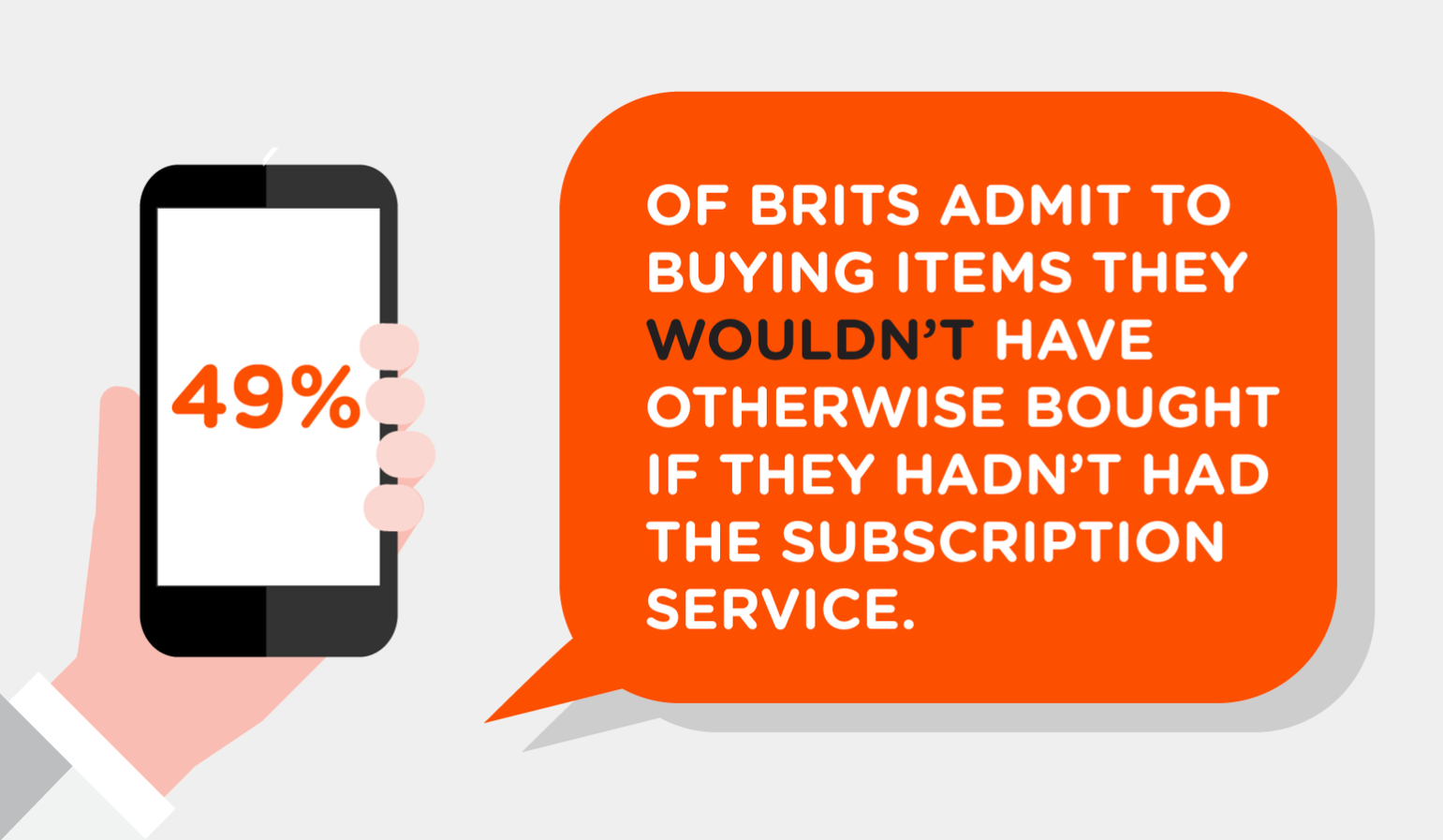How Subscription Services Have Evolved in Response to the Cost-of-Living Crisis
September 2023
Due to the impact of high inflation, UK (United Kingdom) households and businesses continue to navigate the cost-of-living crisis that has been with us since late 2021. It has meant a sharp uptick in costs, increasing energy and raw material prices, and record-high interest rates for both sectors. Subscription-based pricing models aim to provide a new way for consumers to acquire goods and services whilst managing more predictable outgoings and for businesses to retain strong sales figures.
Brits spend a cumulative £2 billion every year on subscriptions, with 81% subscribing to at least one. While digital services still hold most of the share, other categories have also started the switch to subscription-based payment methods.
According to YouGov, only 36% of Brits claim they have no subscriptions, and 35% and 34% of people subscribe to online digital viewing platforms or music streaming services, respectively.
Surprisingly, 11% of Brits pay for other subscriptions, matching people who subscribed to magazines, and higher than people who subscribed to newspapers (9%) and other information (2%)

Car manufacturers are also hopping on the trend, with the likes of BMW, Tesla, Volkswagen, and Mercedes offering subscriptions for additional vehicle features, such as pre-payments for servicing plans. While its implementation has long been debated in tech and car circles, manufacturers retain exclusive features on a pay-as-you-go subscription model, and consumers do not seem to mind.
In 2022, Tesla announced that over 285,000 people had signed up to receive its Full Self-Driving (Autopilot) feature on its cars – a monthly subscription ranging from $99 to $199.
This is due to most consumers arguing that product access is the primary objective during a cost-of-living crisis - especially now that outright payments are increasingly heavy on the wallet.
I couldn't think of owning a bicycle since a new one would cost an eighth of what I paid for my car. If I'm to substitute a bicycle for my work commute, a £1500 outright investment would require many miles to pay off. Which is why I subscribed to a bicycle service.
Humza Sohail London resident and Buzzbike owner
The service, he added, had effectively cut down his initial investment to only £20 a month.
And the data backs this up; a study by Barclays Payments found that most consumers are signing up to boxes to save time and benefit from value for money and convenience.

Common Issues for Businesses Offering Subscription Services
Despite their popularity, subscription-based businesses still fall within the purview of companies struggling with the cost-of-living crisis, and adjusting to a shrinking economy, rising costs, and declining purchasing power are still key factors to consider.
The issues above, while significant, are just some of the ones posing a threat to subscription-based businesses. The other two unique to this industry can become obstacles for many companies, too. These are:
1. Subscription Fatigue
59% of U.K. consumers are aware of their monthly subscription expenditures, with the awareness being most robust for 34-56-year-olds. With increased awareness, consumers typically need help juggling hundreds of pounds of monthly subscriptions.
2. Consumer Banking Convenience
Many banks across the U.K. introduced easy cancellation methods on direct debit payments and monthly subscriptions through their mobile apps. Consumers now have more control over how they manage their subscriptions, resulting in an increase in average subscription length, to around nine months from 5.6 months in 2017.
How Can Subscription-Based Businesses Stay Competitive?
Emerging tactics and methods are helping subscription businesses stay competitive and profitable. Some of them include:
1. Variable Subscription Models
Variable subscription models have become as a beacon of adaptability, offering consumers a spectrum of pricing options. Among these models, the fixed-rate subscription stands as a pillar of stability. It allows subscribers to enjoy their services at a consistent monthly fee, granting them a sense of financial predictability during uncertain times.
The usage-based subscription model has emerged as a lifeline for people acutely aware of their consumption patterns and budget constraints. With costs directly tied to usage levels, this model ensures subscribers only pay for what they use, giving them greater control over their expenses. This flexibility is a vital tool for navigating the peaks and valleys of the current economic landscape.
Lastly, the surcharge subscription model has also come to the fore in the quest to strike a balance between affordability and premium offerings. By introducing supplementary fees for enhanced features or exclusive content, businesses can cater to budget-conscious customers and those seeking a more comprehensive experience.
2. Multiple Subscription Plans
Adopting varying subscription plans has also catered to the changing financial landscape. Among these plans, product sampling has emerged as a strategic cornerstone, allowing consumers to experience a glimpse of the subscription service at a fraction of the cost.
Similarly, free trials have become a trusted ally for consumers and businesses. By providing a limited time to explore the full range of services without commitment, free trials empower consumers to make informed decisions about their subscriptions.
The freemium model also offers a free basic version of the service while enticing users to upgrade to premium features. In an era where financial prudence is paramount, this model lets individuals access essential services without imposing an immediate financial burden.
However, recognising the necessity to sustain quality services amidst economic uncertainties, the paid acquisition model has also gained prominence. This model ensures that subscribers pay a nominal upfront fee to gain access to the subscription service's full suite of offerings. While counterintuitive in an era of financial constraint, the paid acquisition model can be seen as an investment, giving subscribers a comprehensive experience that justifies the expense.
3. Data-Led Content
Subscription-based companies leverage data-led content strategies to remain competitive and provide tailored value to their customers. By harnessing the power of data analytics, these companies gain profound insights into their customers' preferences, behaviours, and financial situations. Subscription businesses are curating content that resonates on a personal level, delivering what their customers need during financially challenging times.
Through personalised content recommendations, subscription companies can guide their customers toward the most relevant offerings, ensuring that every subscription dollar spent yields maximum value. Moreover, these data-driven insights empower companies to introduce pricing structures and subscription tiers that cater to various budget levels, accommodating a wide range of financial capacities.
Additionally, data-led content strategies allow subscription businesses to anticipate changing trends and pivot their offerings swiftly. By monitoring consumption patterns, economic shifts, and user feedback, these companies can fine-tune their content lineup to align with evolving consumer demands. This adaptability not only keeps customers engaged but also fosters a sense of loyalty as customers witness their subscription services proactively adjusting to their circumstances.
4. Staying Social
Companies are also harnessing the dynamic force of social media to fuel excitement and desirability through viral and affiliate marketing strategies. Leveraging the viral nature of social platforms, these companies craft captivating content that resonates with their target audience, encouraging them to share and engage.
By leveraging trending challenges, interactive polls, and relatable user-generated content, subscription brands create a sense of community and relatability, fostering a buzz that transcends financial concerns.
Affiliate marketing emerges as another potent weapon in their arsenal, allowing companies to tap into the reach of influencers and advocates. Collaborations with influencers who align with their brand ethos provide authentic endorsements that resonate deeply with followers. These partnerships not only extend the reach of subscription services but also establish a sense of trust and credibility in the minds of consumers, even during a cost-sensitive climate.
Reimagining Delivery and Supply Chain
In today's competitive landscape, subscription-based companies are strategically adopting innovative methods to enhance their delivery processes, especially in the face of challenges like the cost-of-living crisis. Three prominent strategies - Click and Collect (C&C), B.O.P.I.S. (Buy Online Pay in Store), and D2C (Direct to Consumer) - have emerged as game-changers in this context.
Click and Collect (C&C) empowers customers by allowing them to place orders online and pick them up at a convenient physical location. This approach not only saves time for subscribers but also reduces delivery-related costs for the business. By leveraging existing physical infrastructure, such as retail stores or designated pickup points, subscription companies streamline their operations while offering customers flexibility and convenience.
B.O.P.I.S. (Buy Online Pay in Store) combines online shopping with in-store payment and pickup. This strategy capitalises on the strengths of both digital and brick-and-mortar retail, providing subscribers with the ease of online selection and the security of an in-person transaction. Subscription companies that integrate B.O.P.I.S. into their model create a seamless experience that caters to different customer preferences and helps mitigate any challenges tied to the cost-of-living crisis.
Direct-to-consumer (D2C) strategies involve subscription companies directly controlling their distribution and delivery processes. These businesses gain greater control over the end-to-end customer journey by managing logistics and fulfilment. D2C allows for a more personalised experience and enables subscription companies to optimise delivery routes, reduce third-party costs, and maintain better product quality control.
However, while these strategies can provide reasonable savings in the short term, operational costs can increase alongside customer dissatisfaction. The issue of customer dissatisfaction is essential to note as the speed of delivery has become the decisive contributor to abandoned carts on eCommerce websites.
Partnering with reliable logistics and fulfilment services in the U.K. may be the most stable approach.
Whistl - Business Process Outsourcing Solutions for Subscription-Based Businesses
Whistl provides a unique portfolio of outsourced operations solutions for eCommerce retailers, the public sector, and various other industries, including B.P.O. call centre services and end-to-end logistics. From customer data handling to customs clearance and delivery management, Whistl can help you enhance your customer experience.
Contact our team today to learn more about Whistl's business process outsourcing solutions.
Join our mailing list
Sign up and receive all the latest industry news and insights directly to your inbox.
Research, Insights and Industry Guides
In depth insights and research studies to help you better understand customer perceptions & expectations.
Share this article
International Logistics Memberships and Accreditations

Contact us to find out more!
We'll help you find the right courier management software solutions for your business needs.
Call us
We'll call you
Complete our contact form



